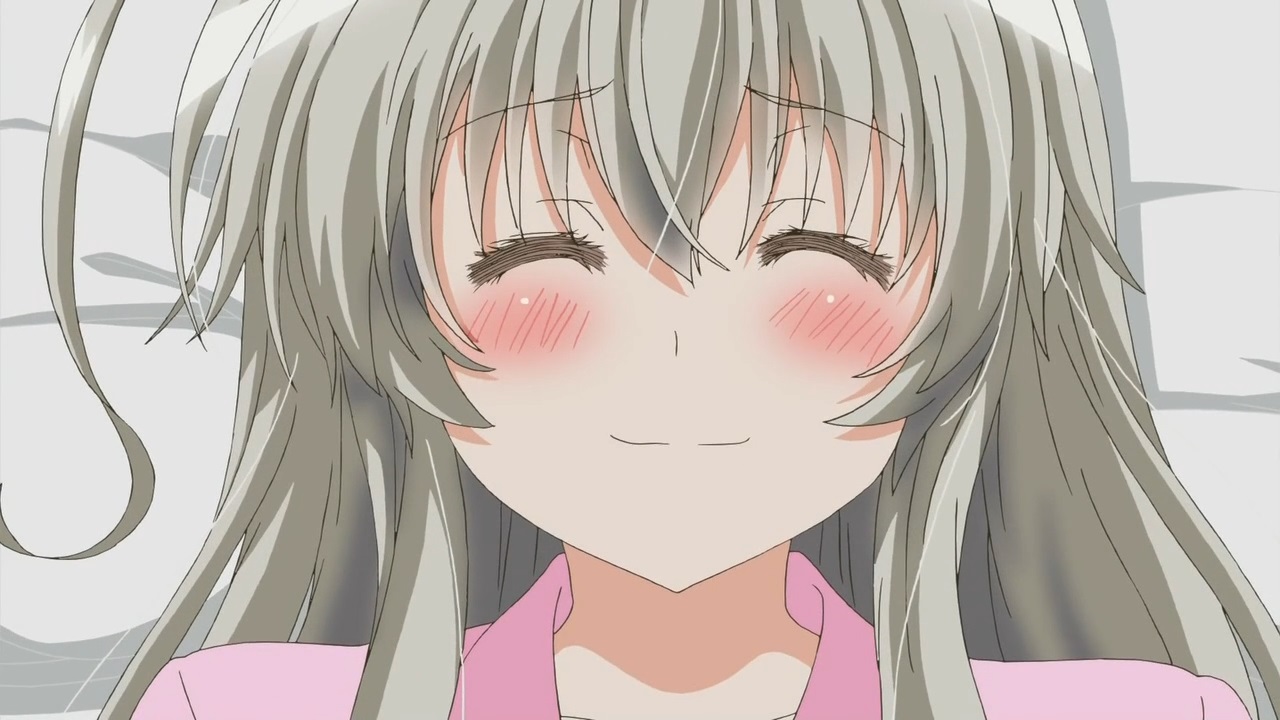Haiyore! Nyaruko-san W Episode 10 References
"Vincent van Gogh!" (0:20)
Vincent van Gogh (ヴィンセント・ヴァン・ゴッホ) was a Dutch impressionist painter who lived from 1853 to 1890.S1
"Judekka Gohho!" (0:27)
"Judekka Gohho" (ジュデッカゴッホ) is referencing a character named Judecca Gozzo (ジュデッカ・ゴッツォ) from "Suupaa Robotto Taisen" (スーパーロボット大戦), "Super Robot Wars", a video game series that first began release in 1991.S1
"Oh, wow! It says 90 degrees celsius." (0:34)
"Kyuujuudo" (九十度), "90 degree celsius", is referencing "Ultra Seven" (ウルトラセブン), a Japanese TV show about a super hero from outer space that aired from 1967 to 1968.S1 In episode 48 of the series, the main character, Moroboshi Dan (モロボシ・ダン), notices his weakened condition and says to himself, "Myakuhaku sanbyaku rokujuu, ketsuatsu yonhyaku, netsu ga kyuujuudo chikaku mo aru. Genin ha nanda?" (脈拍360、血圧400、熱が90度近くもある。原因はなんだ?), which translates to, "I have a heart rate of 360, blood pressure of 400, and a fever close to 90 degrees celsius. What's the cause?".
"In the first place, why can an alien catch a cold?" (0:44)
"We don't have immunity to viruses on Earth." (0:47)
This is referencing "The War of the Worlds", a novel written by H. G. Wells and published in 1898.S2 In the novel, Martians weilding overwhelming technological power invade Earth, however they eventually die off due to lack of immunity to bacteria on Earth. As stated in the novel, the Martians were "slain by the putrefactive and disease bacteria against which their systems were unprepared". It is further stated, "But there are no bacteria in Mars, and directly these invaders arrived, directly they drank and fed, our microscopic allies began to work their overthrow."
"Even aliens possessing overwhelming power can have surprising weaknesses, like tomatoes, moon rocks, or music." (1:05)
There are three references here:
* Weakness to tomatoes is referencing "Daijoubu Mai Furendo" (だいじょうぶマイフレンド), "It's All Right My Friend", a Japanese movie released in 1983.S2 The main character of the movie, Gonjii Toroimerai (ゴンジー・トロイメライ), is an alien with super human power, however being near tomatoes makes him weaker.
* Weakness to moon rocks is referencing "Uchuu Daikaijuu Girara" (宇宙大怪獣ギララ), "Giant Space Monster Girara", a Japanese movie released in 1967.S1 In the movie, there is a giant monster from space called Girara that possesses overwhelming power and grows larger and more powerful by absorbing energy. It goes on a rampage on Earth in search of more energy, and all weapons are unable to damage it. Eventually, a substance called Giraranium (ギララニウム) is discovered, which is able to block energy absorption and radiation. It is also discovered that Giraranium is abundantly found in moon rocks. Girara is defeated by bombs full of moon rocks that cover Girara in Giraranium and cause it to weaken and shrink.
* Weakness to music is referencing "Mars Attacks!", an American movie released in 1996.S1 In the movie, Martians weilding overwhelming technological power invade Earth, however it is eventually revealed that the heads of the Martians explode due to hearing "Indian Love Call", a song sung by Slim Whitman and released in 1924.
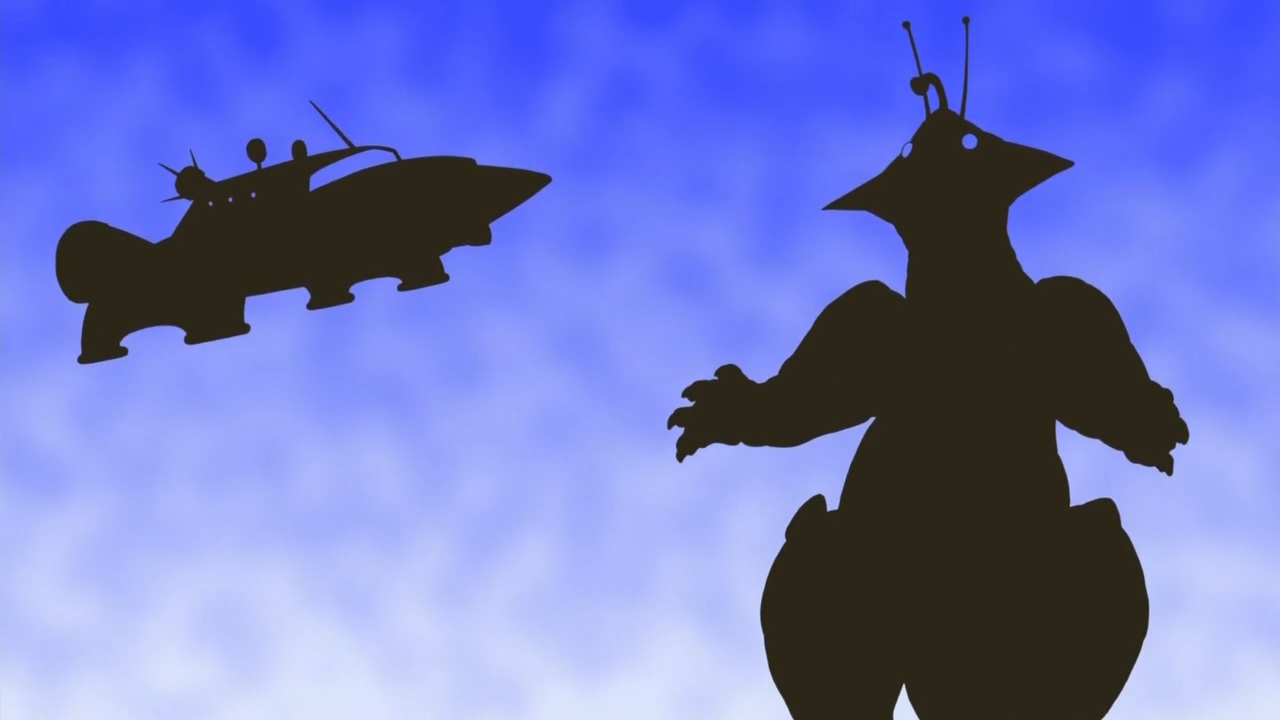
(1:13)
This image appears on screen when Nyaruko mentions weakness to moon rocks. The image contains a silhouette of a space ship called "AAB Ganmaa Gou" (AABガンマー号), "AAB Gamma Model", which appeared in "Uchuu Daikaijuu Girara". The image also contains a silhouette of Girara. Images for reference:
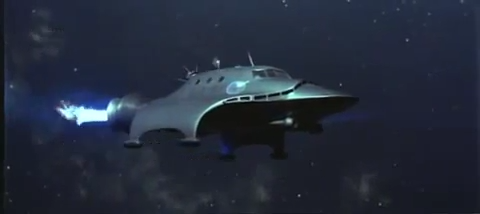
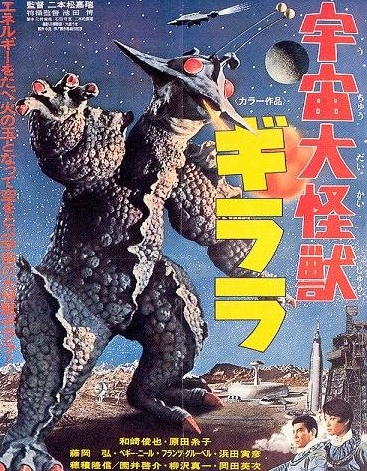
Source of image: https://en.wikipedia.org/wiki/File:The-X-from-Outer-Space.jpg
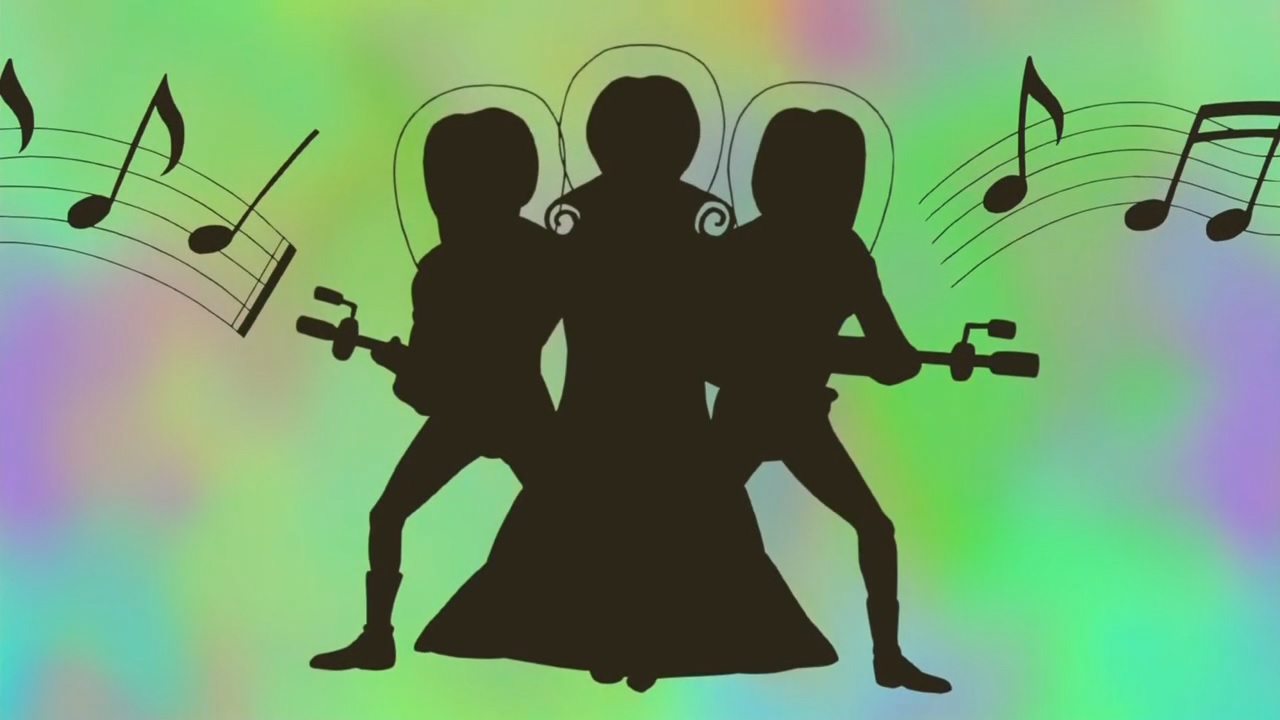
(1:15)
This image appears on screen when Nyaruko mentions weakness to music. The image contains silhouettes of Martians as they appear in "Mars Attacks!". Image for reference:
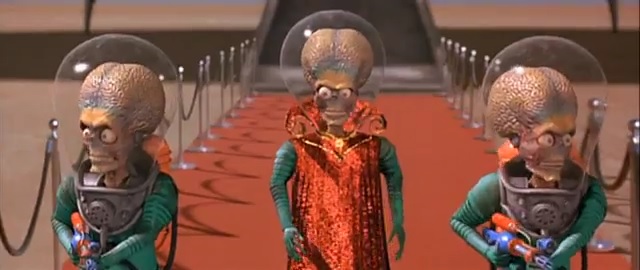
"Come to think of it, giant living weapons who knew only of war lost the will to fight after hearing songs for the first time." (1:18)
This is referencing "Chou Jikuu Yousai Makurosu" (超時空要塞マクロス), "Super Dimension Fortress Macross", an anime series that aired from 1982 to 1983.S4 In the series, there is a species of giant humanoids called Zentradi (ゼントラーディ人) who were created as tools of war. Upon hearing songs from human culture, the Zentradi lose the will to fight.
"Achoo Great Evil God!" (1:27)
The Japanese line is "Hakushon Daijashin!" (ハクション大邪神!). "Hakushon" (ハクション) is the Japanese interpretation of the sound made when someone sneezes. As a whole, "Hakushon Daijashin" is referencing "Hakushon Daimaou" (ハクション大魔王), "Achoo Great Demon King", an anime series that aired from 1969 to 1970.S1 The series is about a genie named Hakushon Daimaou (ハクション大魔王) who is summoned from his pot when someone sneezes.
(1:31)
The line at this time is "Uu nyaa" (うーにゃー). The phrases "uu!" (うー!) and "nyaa!" (にゃー!) are referencing the same lines contained in the lyrics to "Taiyou Iwaku Moeyo Kaosu" (太陽曰く燃えよカオス), the opening theme song to "Haiyore! Nyaruko-san" that aired in 2012. This song is sung by Asumi Kana (阿澄佳奈), Matsuki Miyu (松来未祐), and Ootsubo Yuka (大坪由佳), the voice actors of Nyaruko, Cthuko, and Kurei Tamao respectively.
"We're going to make a heartbeat memorial." (1:42)
"Tokimeki na memoriaru" (ときめきなメモリアル), "heartbeat memorial", is referencing "Tokimeki Memoriaru" (ときめきメモリアル), "Heartbeat Memorial", a video game released in 1994.S2
"The addition of new love interests and plus situation are the natural progression." (2:27)
"Purasu shichueeshon" (プラスシチュエーション), "plus situation", is referencing "D.C.P.S. ~Da Capo~ Plus Situation" (D.C.P.S. ~ダ・カーポ~ プラスシチュエーション), a visual novel released by CIRCUS in 2003.S4 In addition, one of the main characters in this visual novel, Sagisawa Misaki (鷺澤美咲), is voiced by Matsuki Miyu (松来未祐), the voice actor who voices Cthuko.
"I'm going to confess to the boy under the unwithering sakura tree." (2:34)
"Karenai sakura no ki" (枯れない桜の木), "unwithering sakura tree", is referencing "D.C. ~Da Capo~" (D.C. ~ダ・カーポ~), a visual novel released by CIRCUS in 2002.S2 On the official website for this visual novel, the following is stated:
1年中“枯れない桜”が咲き誇る初音島。Image for reference:
Ichinenjuu "karenai sakura" ga sakihokoru Hatsune jima.
On Hatsune Island there is an "unwithering sakura tree" that is in full bloom all year round.
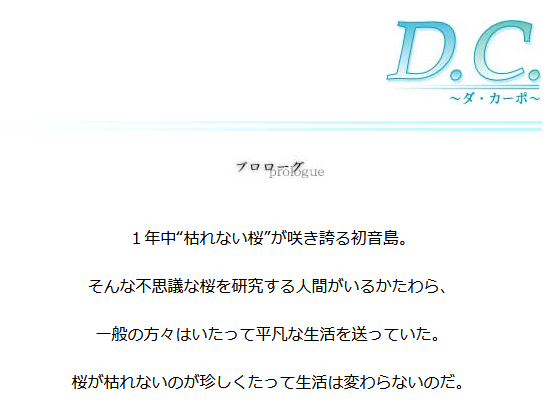
Source of image: http://circus-co.jp/product/dchp/dc/dc_story.html
"Fan disc!" (2:43)
"Fan disuku" (ファンディスク), "fan disc", is a product released by a game company as a follow up to a previous game. A fan disc typically contains bonus material related to the original game.S2
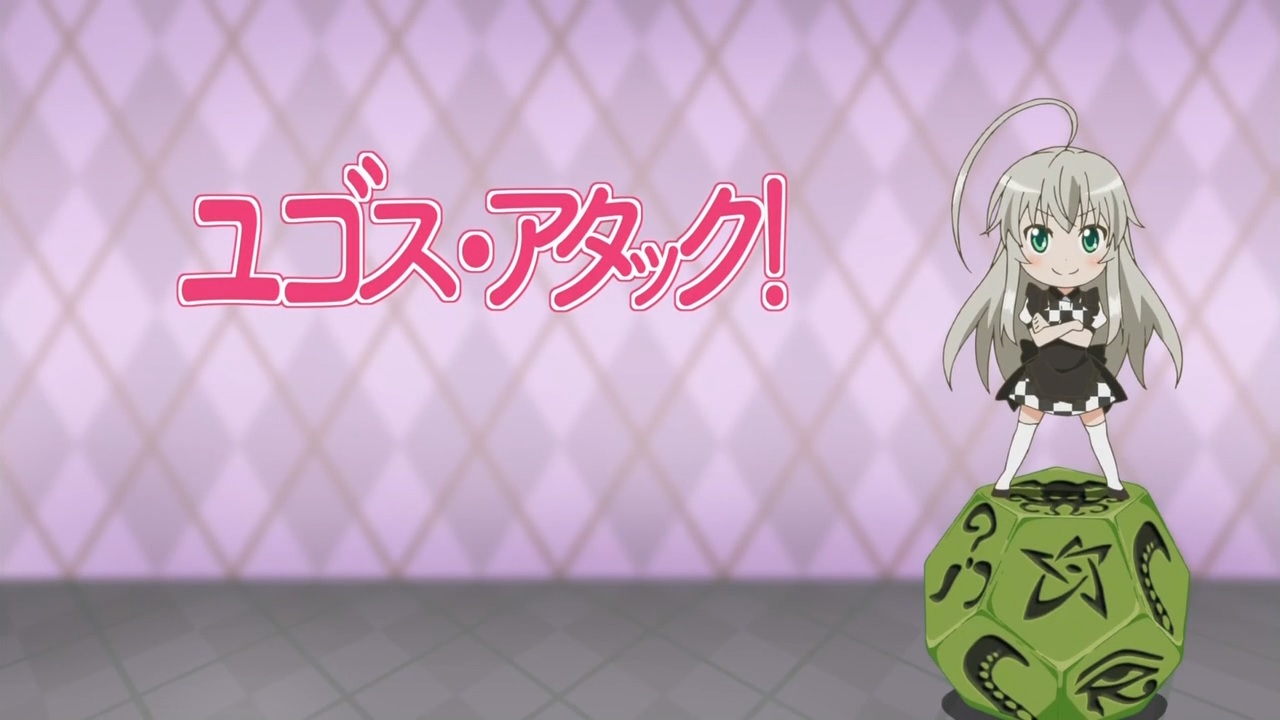
(5:06)
The title of this episode is "Yugosu Atakku!" (ユゴス・アタック!), which translates to "Yuggoth Attack!". There are two references here:
* This is referencing "Mars Attacks!", an American movie released in 1996.S2 In Japan, the film's title is written as "Maazu Atakku!" (マーズ・アタック!), which translates to "Mars Attack!".
* Yuggoth is the name of a fictional planet in the Cthulhu Mythos.
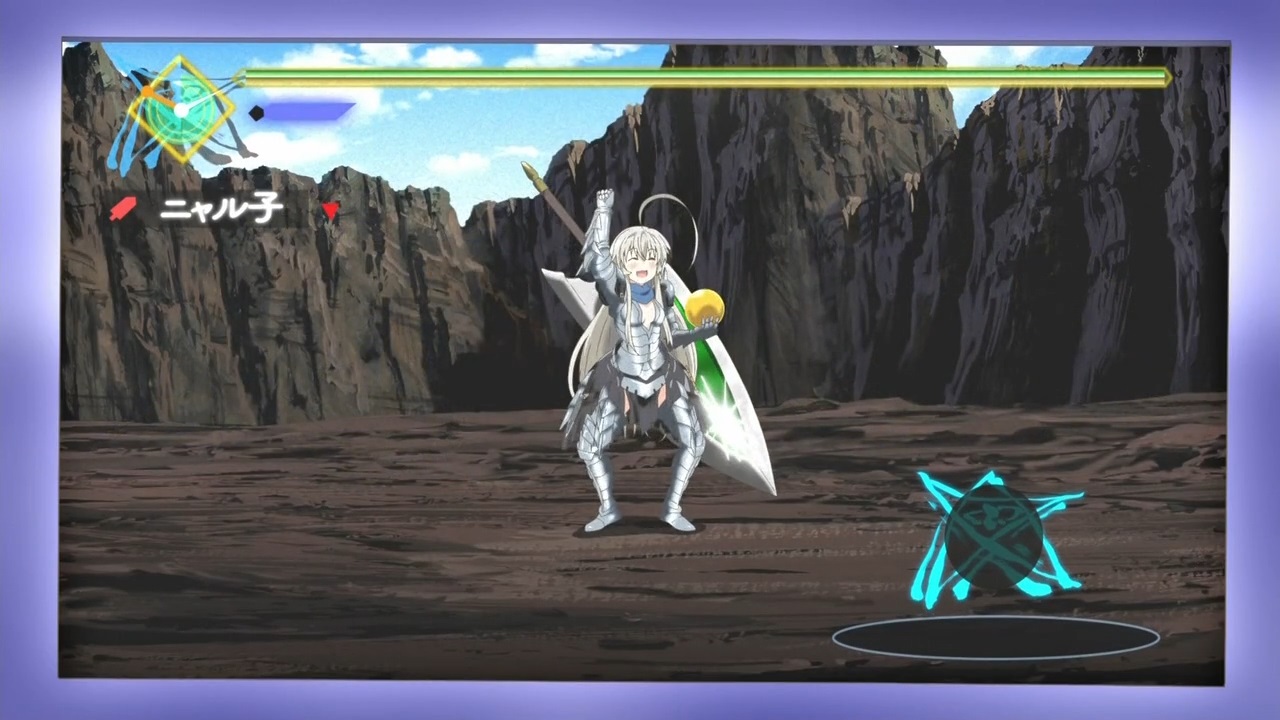
"A rare species ruby dropped!" (6:04)
There are two references here:
* The symbol that appears in the top left and bottom right corners of the screen is referencing August Derleth's description the Elder Sign, a symbol that appears in the Cthulhu Mythos. Image from the 5th edition rule book for the "Call of Cthulhu" RPG for reference:

* The terms "kishoushu" (希少種), "rare species", and "kougyoku" (紅玉), "ruby", and also the game screen are referencing "Monster Hunter G" (モンスターハンターG), a video game released by CAPCOM (カプコン) in 2005. In the game, "kishoushu" (希少種), "rare species", refers to rare monsters, and two species of monsters that are categorized as such are Rare Species Rioreusu (リオレウス希少種) and Rare Species Rioreia (リオレイア希少種). Respectively, these monsters can drop "gin karyuu no kougyoku" (銀火竜の紅玉), "silver fire dragon ruby", and "kin karyuu no kougyouku" (金火竜の紅玉), "gold fire dragon ruby". Images for reference:
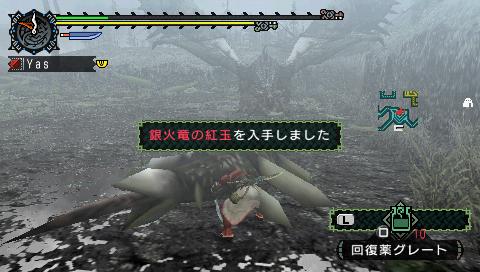
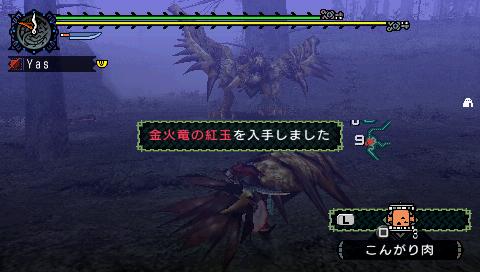
Source of images:
https://plaza.rakuten.co.jp/channaga/diary/200810140000/
https://plaza.rakuten.co.jp/channaga/diary/200810130000/
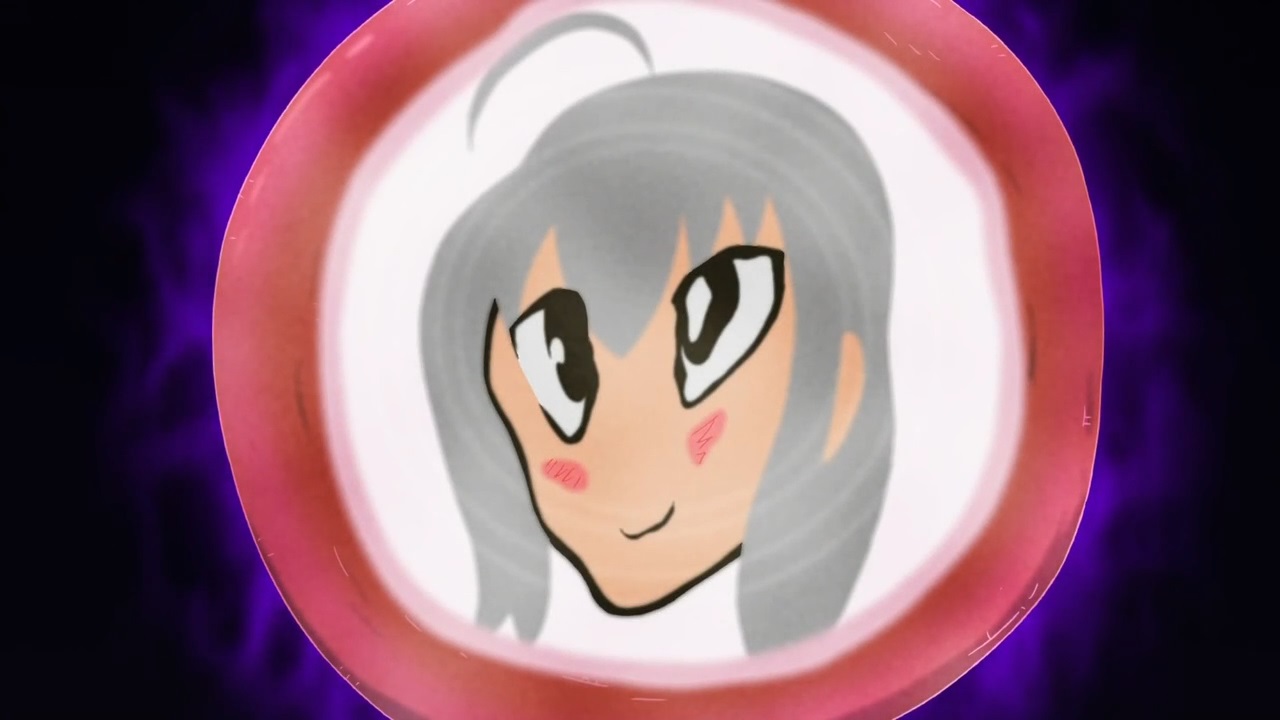
(6:25)
The appearance of the medicinal drop is referencing an actual product produced by GA Bunko (GA文庫), a Japanese publishing label that publishes many books, including the "Haiyore! Nyaruko-san" light novel series.S2 In February of 2011, GA Bunko held a promotion called GA Bunko Valentine Fair 2011 (GA文庫バレンタインフェア2011). During the promotion period, customers who purchased books published by GA Bunko would also receive a piece of candy with an image of Nyaruko's face on it as a gift. Here is a sign explaining the promotion with an example of what the candy looks like:
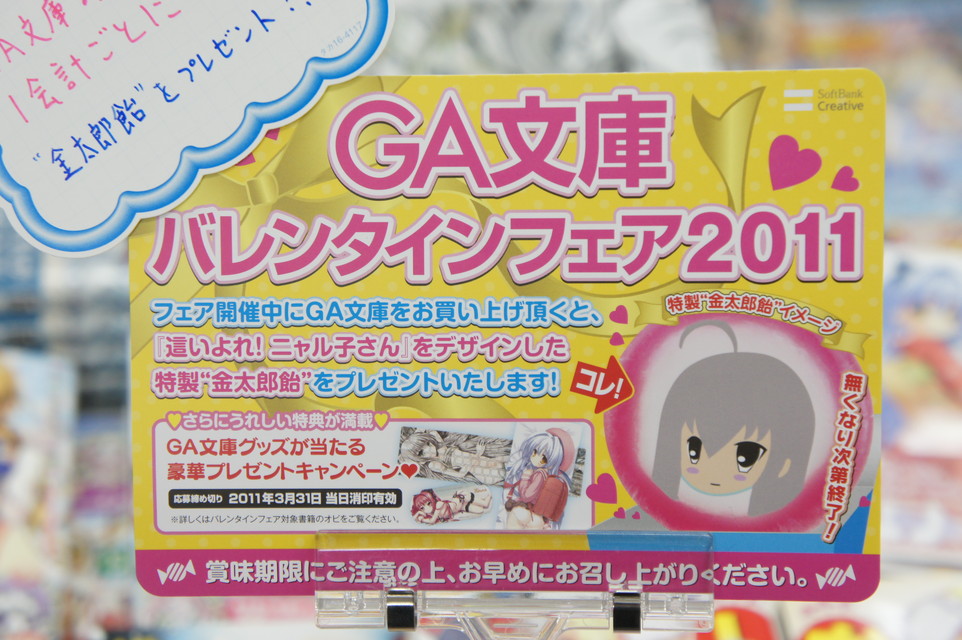
However, the actual product looks very different. Image for reference:
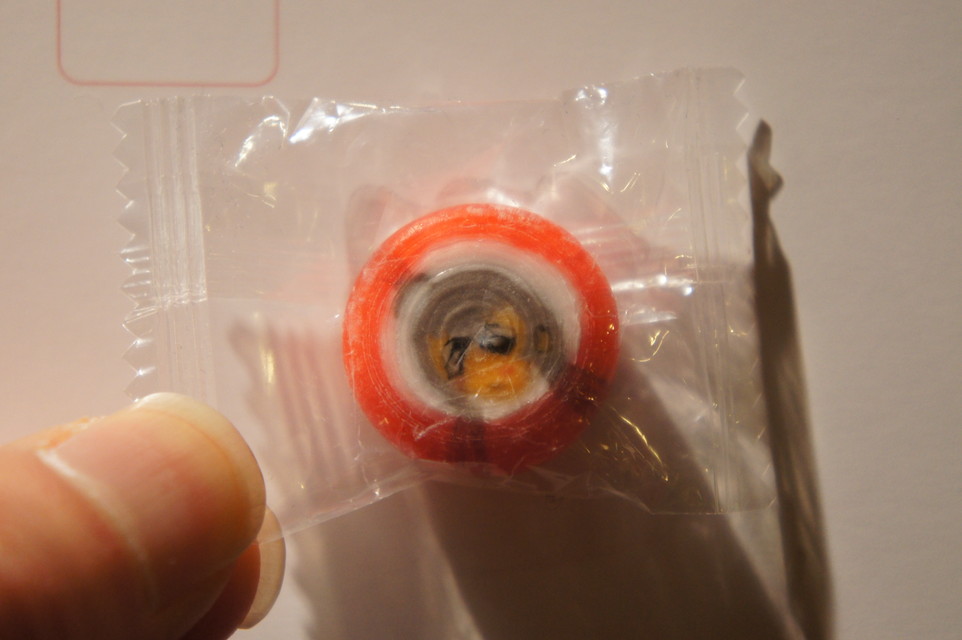
Source of images: http://ieee80211abgn.blog58.fc2.com/blog-entry-1248.html
"It's a medicinal drop that has Great Old One nutrients mixed in." (6:31)
Regarding "eiyouzai gureeto oorudo wan" (栄養剤グレート・オールド・ワン), "Great Old One nutrients", there are two references here:
* This is referencing "eiyouzai" (栄養剤), "nutrients", a recurring item in "Monster Hunter" (モンスターハンター), a series of video games released by CAPCOM (カプコン) starting from 2004.S2
* This is referencing "Great Old One" (グレート・オールド・ワン), a classification of entities in the Cthulhu Mythos that pertains to tremendously powerful creatures that are considered to be on the level of gods. Notable examples include Cthulhu, Cthugha, and Hastur.
(6:36)
The line at this time goes as follows:
「理想と現実はまだ届かないけれど、それでも走り出すしかない」This is referencing lines in the lyrics to "Kamen Rider AGITO 24.7 version" (仮面ライダーAGITO 24.7 version), a song sung by Ishihara Shinichi (石原慎一) and released in 2001. This song is the second opening theme song for "Kamen Rider Agito" (仮面ライダーアギト), a Japanese TV show about a masked super hero that aired from 2001 to 2002.S2 The original lines go as follows:
"Risou to genjitsu ha mada todokanai keredo, sore demo hashiridasu shika nai"
"Ideal and reality are still unreachable, but even so, there's no choice but to start running."
「まだ、届かない理想と現実」
「それでも、走り出す」
"Mada, todokanai risou to genjitsu"
"Sore demo, hashiridasu"
"Ideal and reality are still unreachable"
"Even so, I start running"
"Isn't it great? It's 'The Messenger from Yuggoth!'" (6:51)
The title of the song used as Nyaruko's ring tone is "Yugosu Yori no Shisha" (ユゴスよりの使者), which translates to "The Messenger from Yuggoth". This is referencing "Nichiyoubi Yori no Shisha" (日曜日よりの使者), "The Messenger from Sunday", a song sung by THE HIGH-LOWS and released in 2004.S2
"Buhho Konsherun!" (7:28)
"Buhho Konsherun" (ブッホ・コンツェルン), "Buch Concern", is the name of a group of companies in "Mobile Suit Gundam F91" (機動戦士ガンダムF91), an anime movie released in 1991.S1
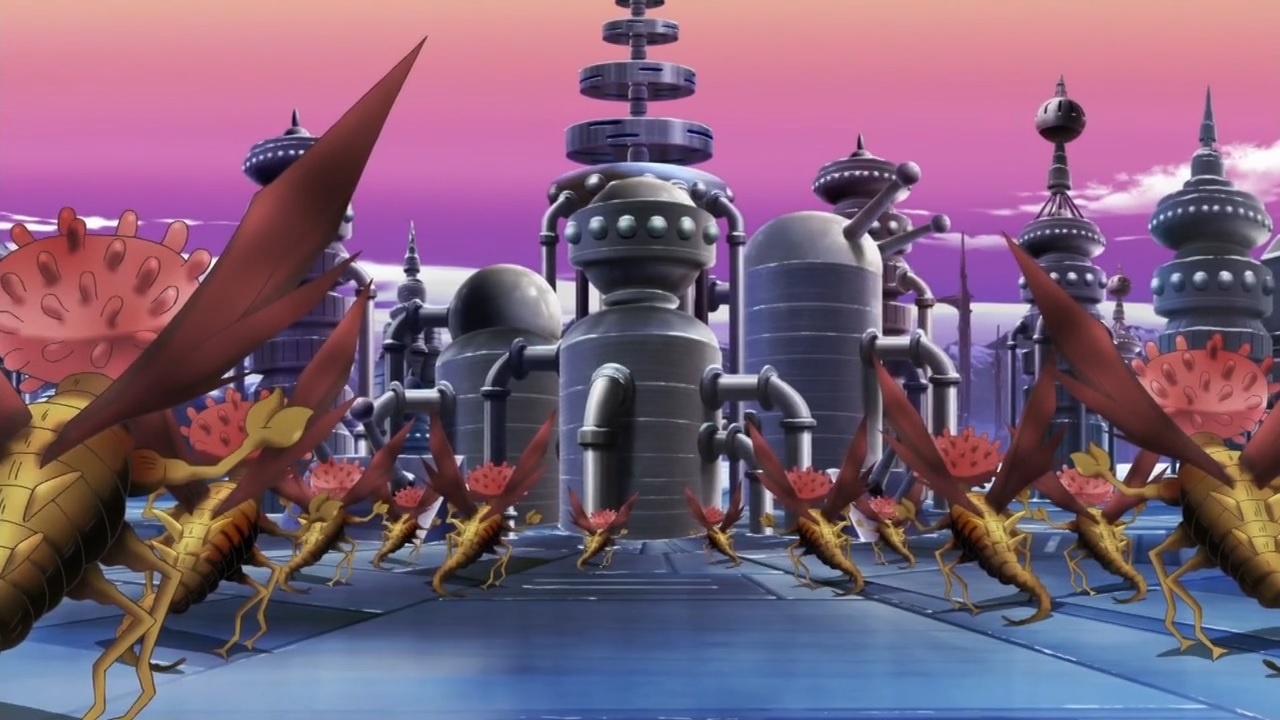
"They're Mi-Go. They're called the fungi from Yuggoth. They're aliens that come from Pluto." (9:22)
There are four references here:
* Mi-Go is a species of creature in the Cthulhu Mythos.
* In "The Whisperer in Darkness", a short story written by H. P. Lovecraft and first published in 1931, it is stated, "They were pinkish things about five feet long; with crustaceous bodies bearing vast pairs of dorsal fins or membraneous wings and several sets of articulated limbs, and with a sort of convoluted ellipsoid, covered with multitudes of very short antennae, where a head would ordinarily be." In addition, it is stated, "They talked with their heads, which changed colour in different ways to mean different things."
* Mi-Go are known as "fungi from Yuggoth", as mentioned in "The Whisperer in Darkness". Hasta says the Mi-Go are called "Yugosu yori no mono" (ユゴスよりのもの), which translates to "things from Yuggoth".
* In "At the Mountains of Madness", a story written by H. P. Lovecraft and first published in 1936, it is stated that the Mi-Go came to Earth from Pluto. In addition, in "The Whisperer in Darkness", the narrator, Albert N. Wilmarth, suspects that Pluto and Yuggoth are the same planet.
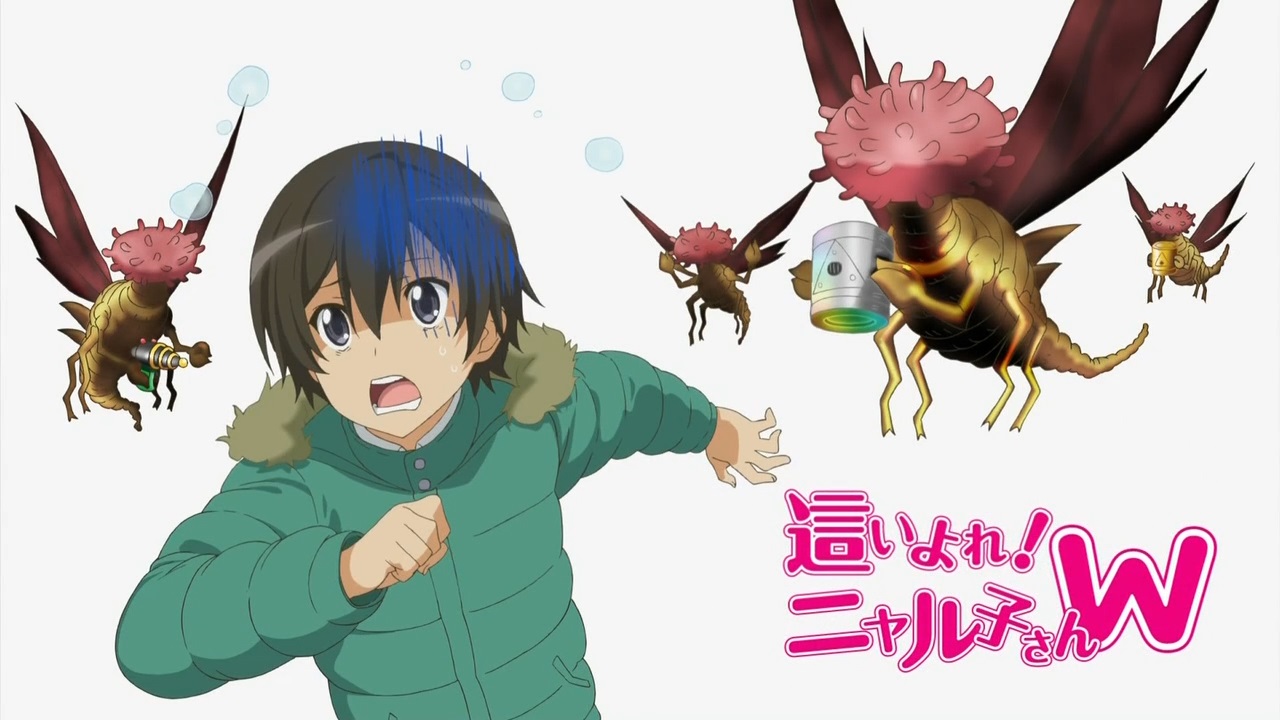
(9:55)
There are three references here:
* As described in "The Whisperer in Darkness", a short story written by H. P. Lovecraft and first published in 1931, Mi-Go are known to carry human brains in metal cylinders in order to transport them through space.S3
* The scene depicted is referencing the cover art of "Mi-go no Noumiso Hanto" (ミ=ゴの脳みそハント!), "Mi-go's Brain Hunt", a board game released by Arclight (アークライト) in 2012.S3 Image for reference:
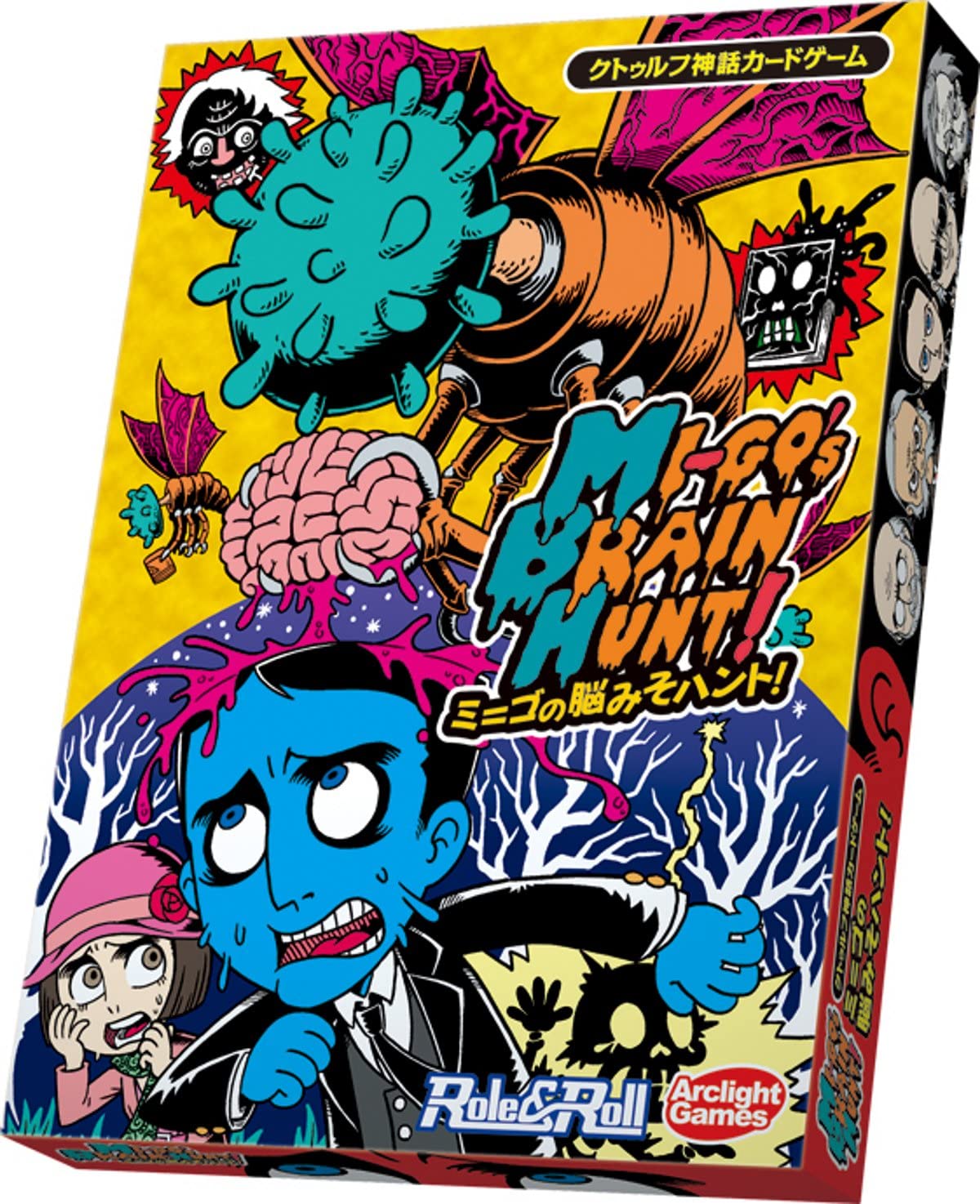
Source of image: https://www.amazon.co.jp/dp/B009YQIJ86
* The line at this time is "Noumiso choodai" (脳ミソちょーだい), which translates to "Please give me your brain". This is referencing the same line said by Aruka (アルカ) in chapter 322 of volume 31 of "HUNTER×HUNTER" (ハンター×ハンター), a manga series written by Togashi Yoshihiro (冨樫義博) and published starting from 1998.S4 Image for reference:
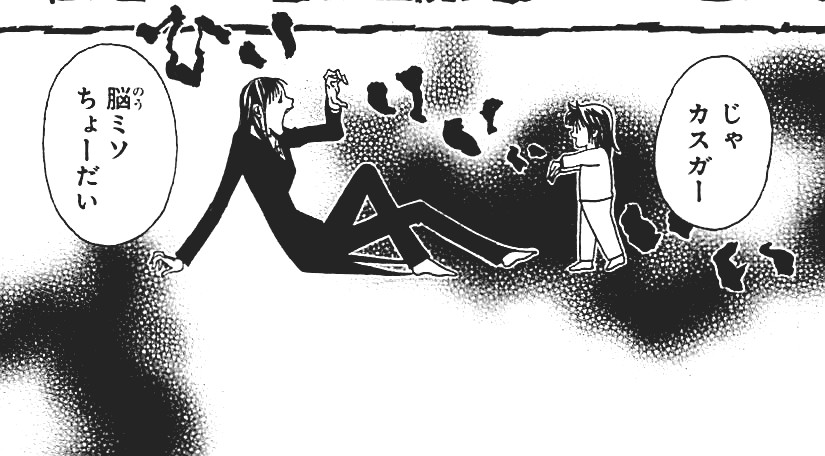
"I'll use that money to go to the pure gentleman's meeting place, the Dreamland Club, and meet Amane!" (11:14)
There are four references here:
* "Doriimurando" (ドリームランド), "Dreamland", is referencing the Dreamland, a fictional location in the Cthulhu Mythos that humans can enter when they fall asleep.
* "Doriimurando Kurabu" (ドリームランドクラブ), "Dreamland Club", is referencing "Doriimu Kurabu" (ドリームクラブ), "Dream Club", a video game released in 2009.S2
* "Pyua na shinshi no shakouba" (ピュアな紳士の社交場), "pure gentleman's meeting place", is also referencing "Dream Club".S2 On the official website for this game, the following is stated.
「当店は、ピュアな心の持ち主だけが入店できる会員制のお店です。」Image for reference:
"Touten ha, pyua na kokoro no mochinushi dake ga nyuuten dekiru kaiinsei no omise desu."
"Only those possessing pure hearts can become members of this establishment."
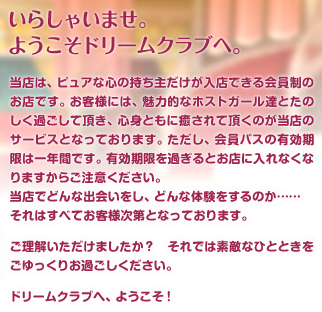
Source of image: http://www.d3p.co.jp/dreamclub_first/
* Amane (亜麻音) is the name of the main heroine in "Dream Club".S2
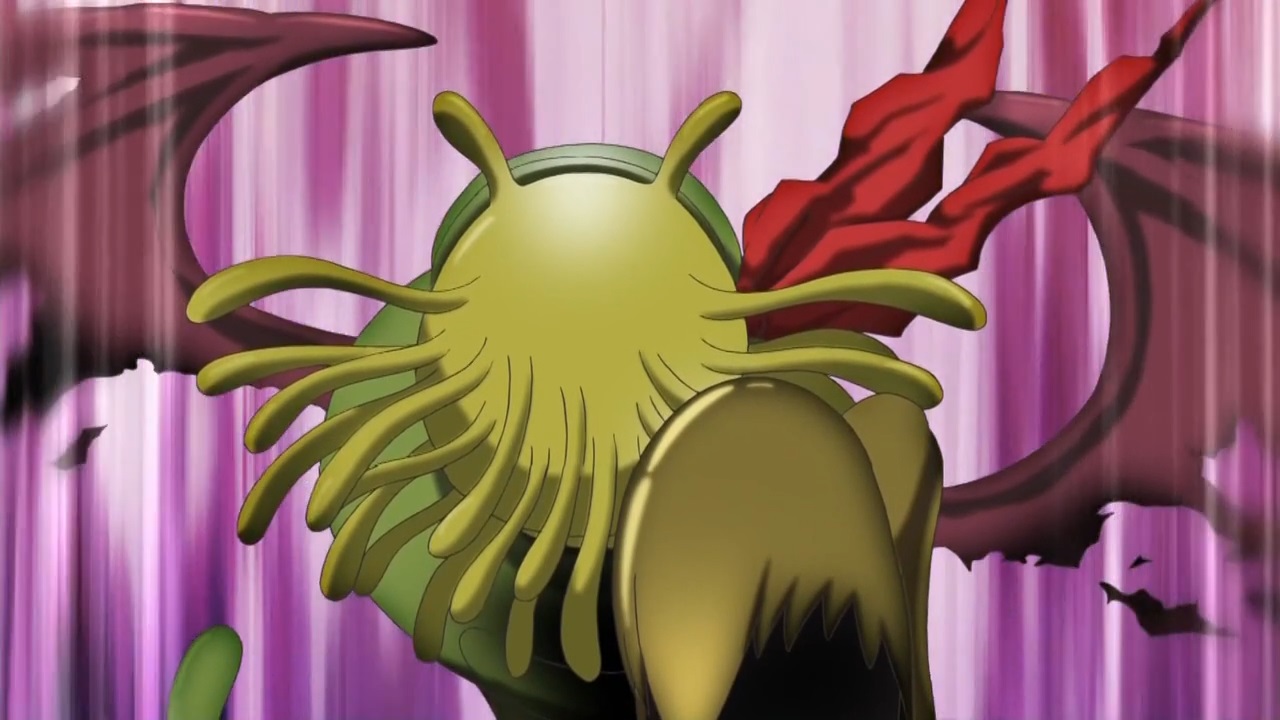
"Zetto!" (11:20)
"Zetto!" (ゼット!) is the Japanese pronunciation of the letter "Z". The exclamation of "Zetto!" (ゼット!), the pointing pose, and the red scarf are all referencing Mizuki Ichiro (水木一郎), a famous Japanese singer.S4 He is well known for exclaiming "Zetto!" (ゼット!) and doing a pointing pose, such as while singing "Mazinger Z" (マジンガーZ), a song of his released in 1972. Additionally, he is known for wearing a red scarf. Image for reference:
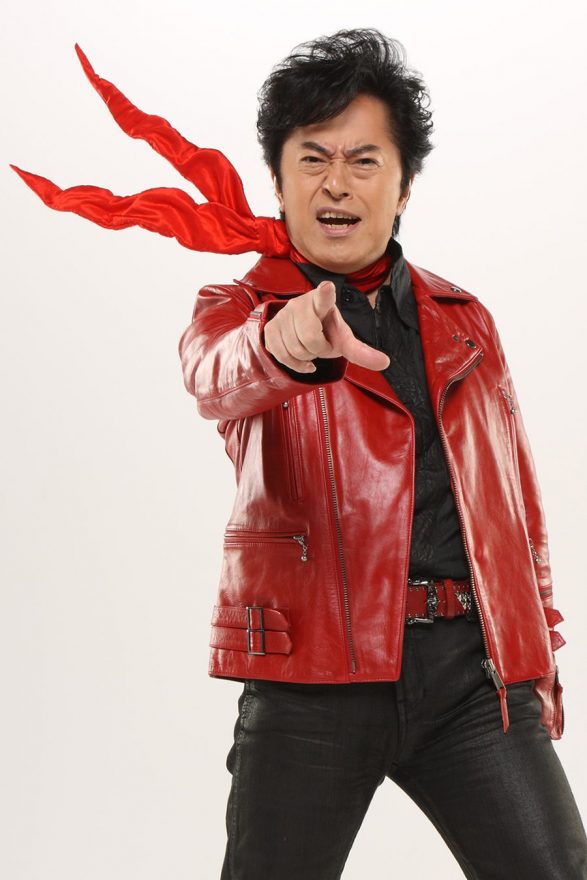
Source of image: https://post.tv-asahi.co.jp/post-41003/
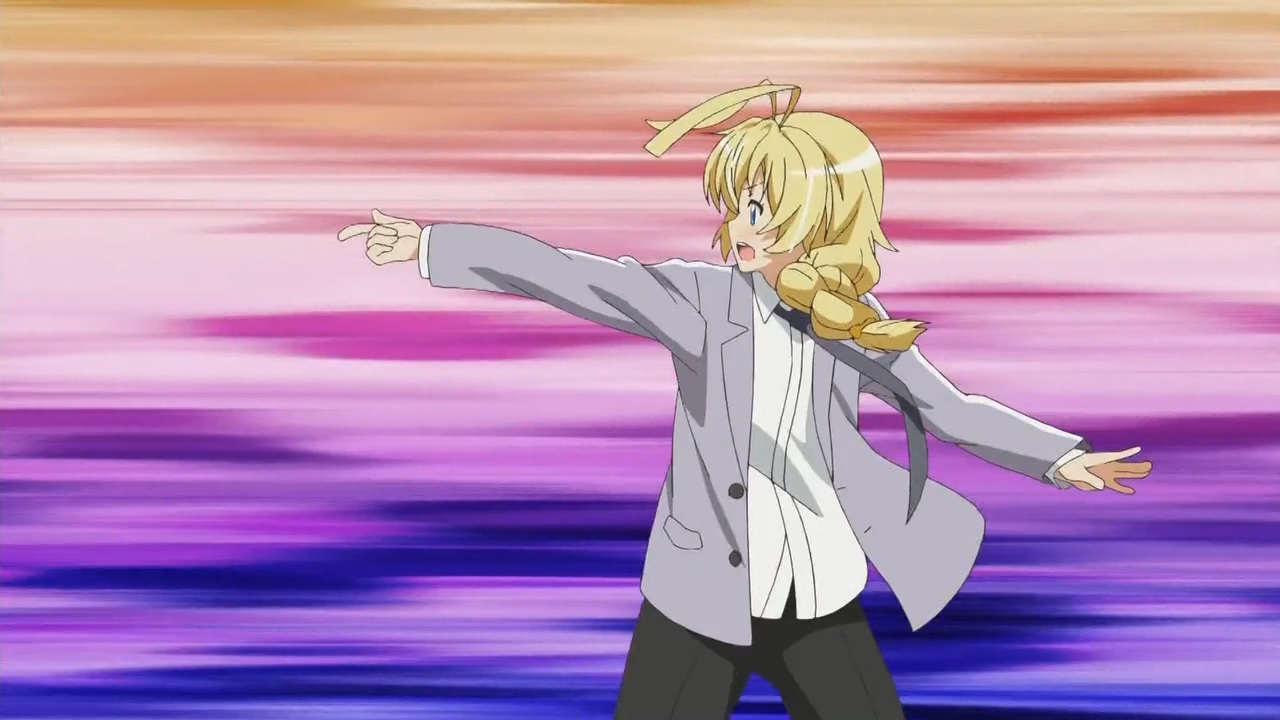
(11:47)
Hasta snaps his fingers to release blades of wind. This is referencing Fabulous Fitzkarald (素晴らしきヒィッツカラルド) from "Jaianto Robo THE ANIMATION -Chikyuu ga Seishi Suru Hi" (ジャイアントロボ THE ANIMATION -地球が静止する日), "GIANT ROBO THE ANIMATION -THE DAY THE EARTH STOOD STILL", an anime series released from 1992 to 1998. In the series, Fitzkarald has the ability to release energy that can slice through objects from his hands by snapping his fingers.
"I won't harm a weak poor ignorant incompetent child of mankind." (13:04)
The Japanese line is "Kyojaku hinjaku muchi munou na hito no ko ni kigai ha kuwaen" (虚弱貧弱無知無能な人の子に危害は加えん). This is referencing a line from "Megami Ibunroku Perusona" (女神異聞録ペルソナ), "Strange Tale of the Goddess Persona", a video game released by ATLUS (アトラス) in 1996.S2 In the game, the player fights against demons, however during a fight it is possible to talk to demons instead. Depending on the player's choices during the conversation, a demon may retreat and say a parting line. There are many different types of demons in the game, and each type says different things. One line that can be said by an Ogre (オーガ) when it retreats is, "De ha, saraba da! Kyojaku hinjaku muchi munou na hito no ko yo!" (では、さらばだ!虚弱貧弱無知無能な人の子よ!), which translates to, "Well then, farewell! Oh weak poor ignorant incompetent child of mankind!". Image for reference:
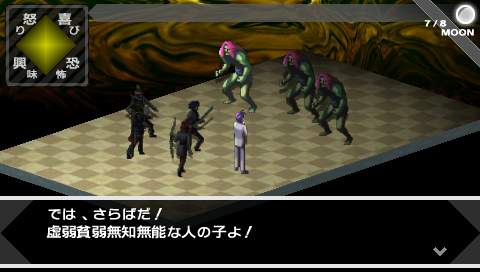
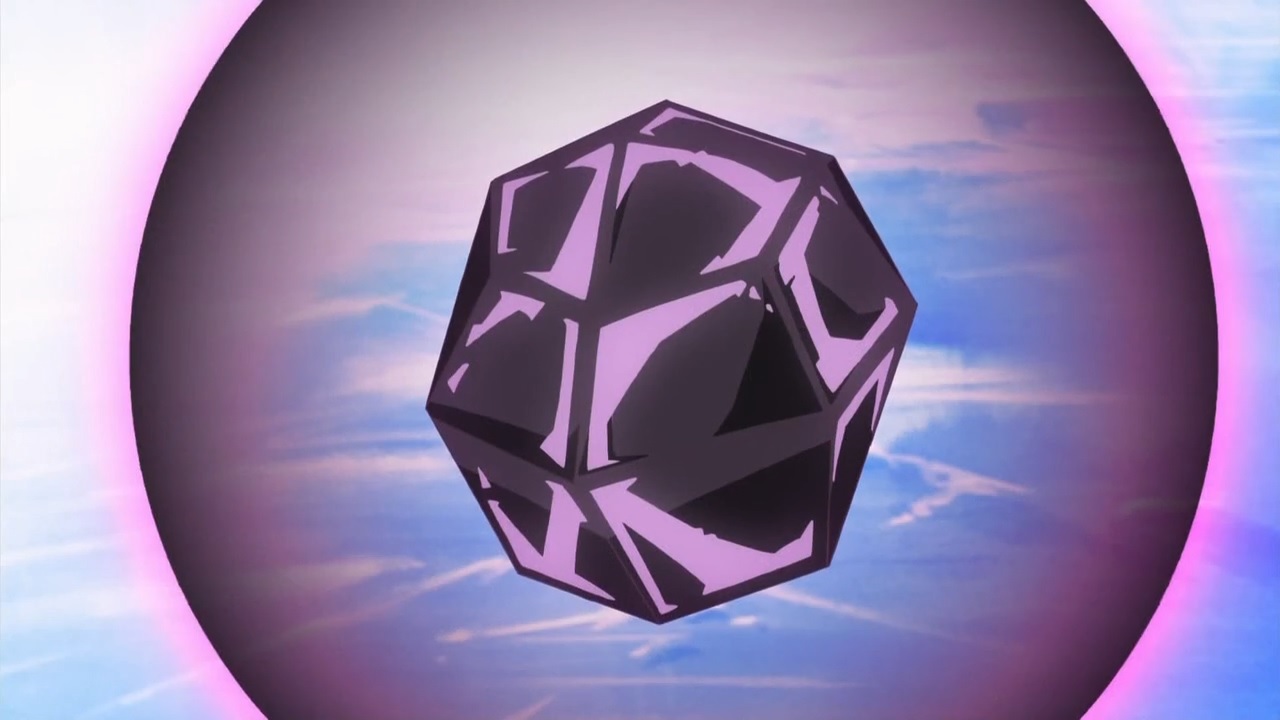
(13:40)
This crystal is based on the Shining Trapezohedron, a mystical crystal that is said to be a window on all time and space. It first appeared in "The Haunter of the Dark", a story written by H. P. Lovecraft and first published in 1936. The Shining Trapezohedron is capable of summoning Nyarlathotep.
"I have arrived!" (13:44)
The Japanese line is "Watashi sanjou!" (私参上!). This is referencing a catch phrase said by Momotarosu (モモタロス) in "Kamen Rider Den-O" (仮面ライダー電王), a Japanese TV show about a masked super hero that aired from 2007 to 2008. His line goes, "Ore sanjou!" (俺参上!), which has the same meaning as above.
"Chaa shuu men tto!" (13:51)
"Chaa shuu men" (チャー・シュー・メン) is referencing the same line said by Mukai Taiyou (向太陽) in "Ashita Tenki ni Naare" (あした天気になあれ), "Tomorrow Will Have Good Weather", a manga series written by Chiba Tetsuya (ちばてつや) and published from 1981 to 1991.S2 He sometimes says this line while doing his golf swing to help him with the timing of his swing. Image for reference:
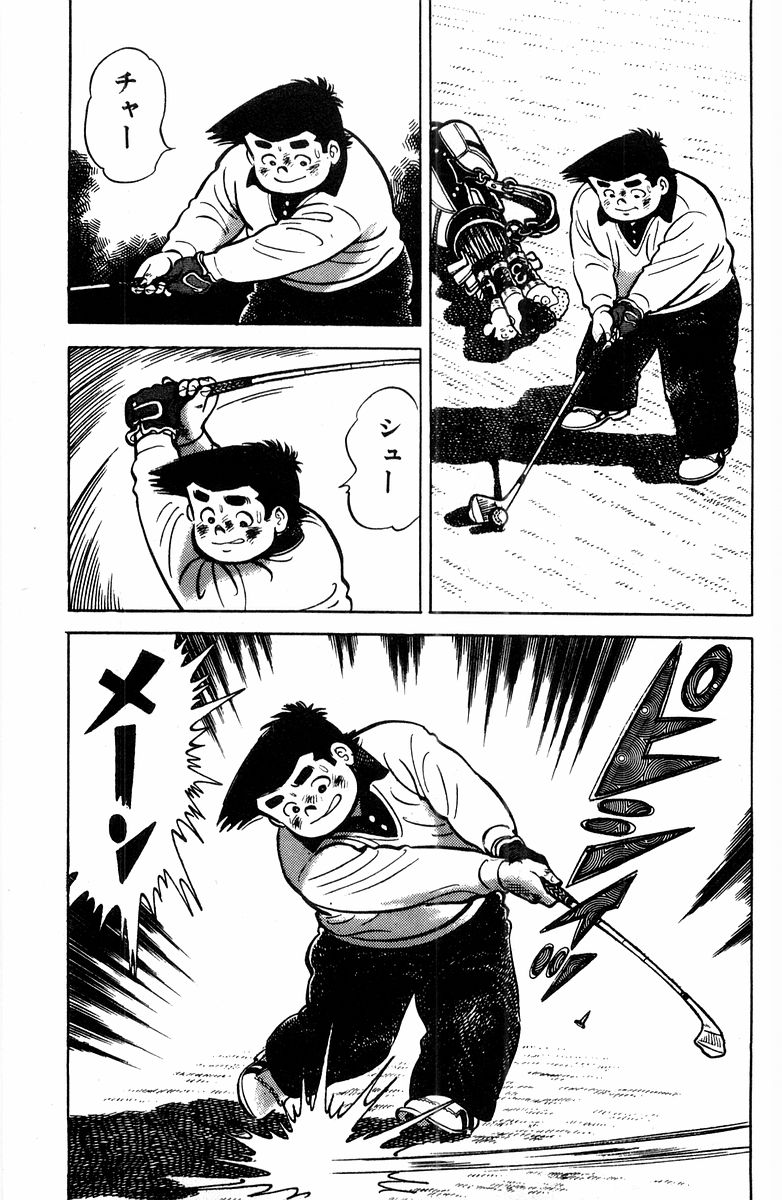
(14:06)
The line at this time goes as follows:
「私の胸にもラブハート!まっすぐ受け止めてデスティニー!」This is referencing a line in the lyrics to "Totsugeki Rabu Haato" (突撃ラブハート), "Charging Love Heart", a song performed by Fire_Bomber (ファイアーボンバー) and released in 1994. This song is a theme song used in "Macross 7" (マクロス7), an anime series that aired from 1994 to 1995.S1 The original line goes as follows:
"Watashi no mune ni mo rabu haato! Massugu uketomete desutinii"
"There's a love heart in my chest, too! Accept it straight on, destiny!"
「お前の胸にもラブハート まっすぐ受け止めてデスティニー」
"Omae no mune ni mo rabu haato massugu uketomete desutinii"
"There's a love heart in your chest, too. Accept it straight on, destiny"
(15:12)
The line at this time go as follows:
「キリキリ舞いさせますよー!ダッシュ!ダッシュ!ダッシュ!キック!エンドBダッシュ!」There are two references here:
"Kirikiri mai sasemasu yoo! Dasshu! Dasshu! Dasshu! Kikku! Endo Bii Dasshu!"
"I'll send you spinning! Dash! Dash! Dash! Kick! And B Dash!"
* This is referencing lines in the lyrics to "Moete Hiiroo" (燃えてヒーロー), "Burn up Hero", a song sung by Okita Hiroyuki (沖田浩之) and Ogai Youko (小粥よう子) and released in 1983.S2 This song is the opening theme song to "Captain Tsubasa" (キャプテン翼), an anime series that aired from 1983 to 1986. The original lines go as follows:
「ボールひとつに キリキリ舞いさ」* This is referencing "Bii Dasshu" (Bダッシュ), "B Dash", a term used to describe a video game controller input that involves pressing and holding the B button while moving in order to move faster than usual.S4 This controller input was first used in "Super Mario Bros." (スーパーマリオブラザーズ), a video game released by Nintendo (任天堂) in 1985.
「ダッシュ ダッシュ ダッシュ」
「キック・エンド・ダッシュ」
"Booru hitotsu ni kirikiri mai sa"
"Dasshu dasshu dasshu"
"Kikku endo dasshu"
"The ball is sent spinning"
"Dash dash dash"
"Kick and dash"
"Shell Bullet of!" (15:39)
The Japanese line is "Danzai no!" (断罪の!). Nyaruko was about to say "Danzai no Sheru Buritto" (断罪のシェルブリット), which translates to "Shell Bullet of Conviction". This is referencing Kazuma from "s.CRY.ed" (スクライド), an anime series that aired in 2001. A drama CD for the series titled "s.CRY.ed sound edition 1" (スクライド サウンドエディション1) was released in 2001. One of the tracks on this CD is titled "s.CRY.ed Comic Edition 'Treasoner'" (スクライド コミック・エディション「トリーズナー」). One of Kazuma's lines from this track goes as follows.S5
「信念を弾丸に込め、撃ち出す!これが、俺の必殺技!断罪のシェルブリットだ!」
"Shinnen wo dangan ni kome, uchidasu! Kore ga, ore no hissatsu waza! Danzai no Sheru Buritto da!"
"I load conviction into a bullet, and shoot! This is, my certain kill technique! The Shell Bullet of Conviction!"
"Foundation!" (16:15)
"Faundeeshon" (ファウンデーション), "foundation", is possibly referencing "Kougami Faundeeshon" (鴻上ファウンデーション), "Kougami Foundation", from "Kamen Rider OOO" (仮面ライダーオーズ), a Japanese TV show about a masked super hero that aired from 2010 to 2011.S2
"Function key!" (16:19)
"Fankushon kii" (ファンクションキー), "function key", is a button on some keyboards.S2
"Phalanx!" (16:54)
"Farankusu" (ファランクス), "Phalanx", is referencing a military robot called "Desutoroido Farankusu" (デストロイド・ファランクス), "Destroid Phalanx", from "Chou Jikuu Yousai Makurosu" (超時空要塞マクロス), "Super Dimension Fortress Macross", an anime series that aired from 1982 to 1983.S4
"VF-1!" (17:10)
"Bui efu wan" (ブイエフワン), "VF-1", is referencing a military aircraft called "VF-1 Valkyrie" (VF-1 バルキリー) from "Chou Jikuu Yousai Makurosu" (超時空要塞マクロス), "Super Dimension Fortress Macross", an anime series that aired from 1982 to 1983.S2
"Big one!" (17:33)
"Biggu Wan" (ビッグワン), "Big One", is the name of a character from "Jakkaa Dengekitai" (ジャッカー電撃隊), "J.A.K.Q. Electrifying Squadron", a Japanese TV show about a squadron of costumed super heroes that aired in 1977.S2
"Wait for me, Amane! I going to buy 'The Golden Marionette' and the daily necessities set for you!" (18:26)
As mentioned above, Amane (亜麻音) is the name of the main heroine in "Doriimu Kurabu" (ドリームクラブ), "Dream Club", a video game released in 2009. "Kiniro no marionetto" (金色のマリオネット), "The Golden Marionette", and "nichiyouhin setto" (日用品セット), "daily necessities set", are items that make Amane happy when given to her.S2 In particular, "Kiniro no Marionetto" (金色のマリオネット), "The Golden Marionette", is the title of an out of print picture book that Amane liked when she was a child. Both of these items need to be given to Amane in order to reach the happy ending with her. Images for reference:
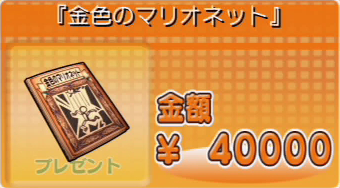
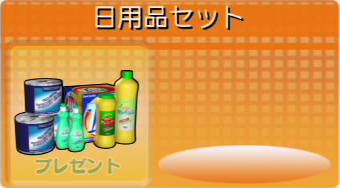
Source of images: https://sites.google.com/site/fhddreamcclub/home/amane
"Stop it! Stop the song!" (19:18)
The Japanese line is "Yamero! U, Uta wo yamero!" (やめろ!う、歌をやめろ!). This is referencing a line said by Gyiyg (ギーグ) in "MOTHER" (マザー), a video game released in 1989.S2 The original line is, "U Uta wo yamero!" (う うたを やめろ!), which translates to "Stop the song!". Image for reference:
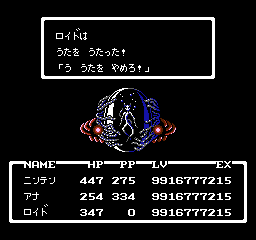
Source of image: https://legendsoflocalization.com/research-mother-earthbound-beginnings/22/
(19:25)
The heads of the Mi-Go explode due to hearing the song. This is referencing how the heads of the Martians explode due to hearing the song "Indian Love Call" sung by Slim Whitman in "Mars Attacks!".S1
"Plug in. The Messenger from Yuggoth. Transmission." (19:50)
The Japanese line is "Puragu in. Yugosu yori no shisha. Toransumisshon" (プラグイン。ユゴスよりの使者。トランスミッション). This is referencing a line said by Hikari Netto (光熱斗) in "Battle Network Rockman.EXE" (バトルネットワーク ロックマンエグゼ), a video game released by CAPCOM (カプコン) in 2001.S1 His line goes, "Puragu in! Rokkuman eguze, toransumisshon!" (プラグイン!!ロックマン.EXE、トランスミッション!), which translates to "Plug in! Rockman.EXE, transmission!". Image for reference:
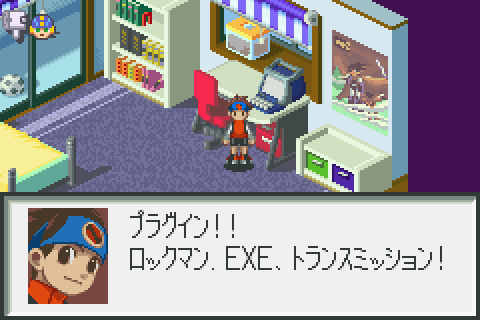
On a related note, an anime adaptation of this game, "Rockman.EXE" (ロックマンエグゼ), aired from 2002 to 2003 and was animated by Xebec (ジーベック), which is the same animation studio that animated "Haiyore! Nyaruko-san" and "Haiyore! Nyaruko-san W".S4
"Why were we defeated, by this song?" (20:17)
The Japanese line is "Naze wareware ha, konna uta ni yabureta no da?" (なぜ我々は、こんな歌に破れたのだ?). This is referencing a line said by Gyiyg (ギーグ) in "MOTHER" (マザー).S2 The original line is, "Naze kono watashi ga konna uta ni yabureta no da...." (ナゼ コノワタシガ コンナウタニ ヤブレタノダ・・・・), which translates to, "Why was I defeated by this song....". Image for reference:
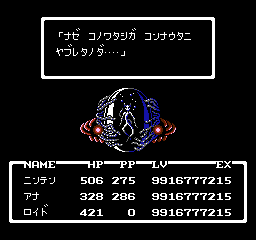
Source of image: https://legendsoflocalization.com/research-mother-earthbound-beginnings/22/
"Even though I gallantly appeared" (20:41)
The Japanese line is "Sassou toujou shita no ni" (颯爽登場したのに). This is referencing a catch phrase said by Tsunashi Takuto (ツナシ・タクト) in "STAR DRIVER Kagayaki no Takuto" (STAR DRIVER 輝きのタクト), "STAR DRIVER: Takuto of the Radiance", an anime series that aired from 2010 to 2011.S2 His line goes, "Sassou Toujou! Ginga Bishounen, Taubaan!" (颯爽登場!銀河美少年、タウバーン!), which translates to "Gallantly appearing! Galactic Pretty Boy, Tauburn!".
"Deculture" (20:28)
"Dekaruchaa" (デカルチャー) is a term used in "Chou Jikuu Yousai Makurosu Ai Oboeteimasu ka" (超時空要塞マクロス 愛・おぼえていますか), "The Super Dimension Fortress Macross: Do You Remember Love?", a movie released in 1984. The term is used by the Zentradi (ゼントラーディ人), a species of giant humanoids, to express shock or surprise. Since this movie, the term has been used in other "Macross" series, such as Macross 7 (マクロス7), aired from 1994 to 1995, and "Macross Frontier" (マクロスF), aired in 2008. The meaning of the term has also changed over time to express amazement.
(23:41 - 23:51)
The scene during this time is from the OVA episode of "Haiyore! Nyaruko-san". Post for reference: https://nyaruref.github.io/nyaruko/nyaruko_ova.html
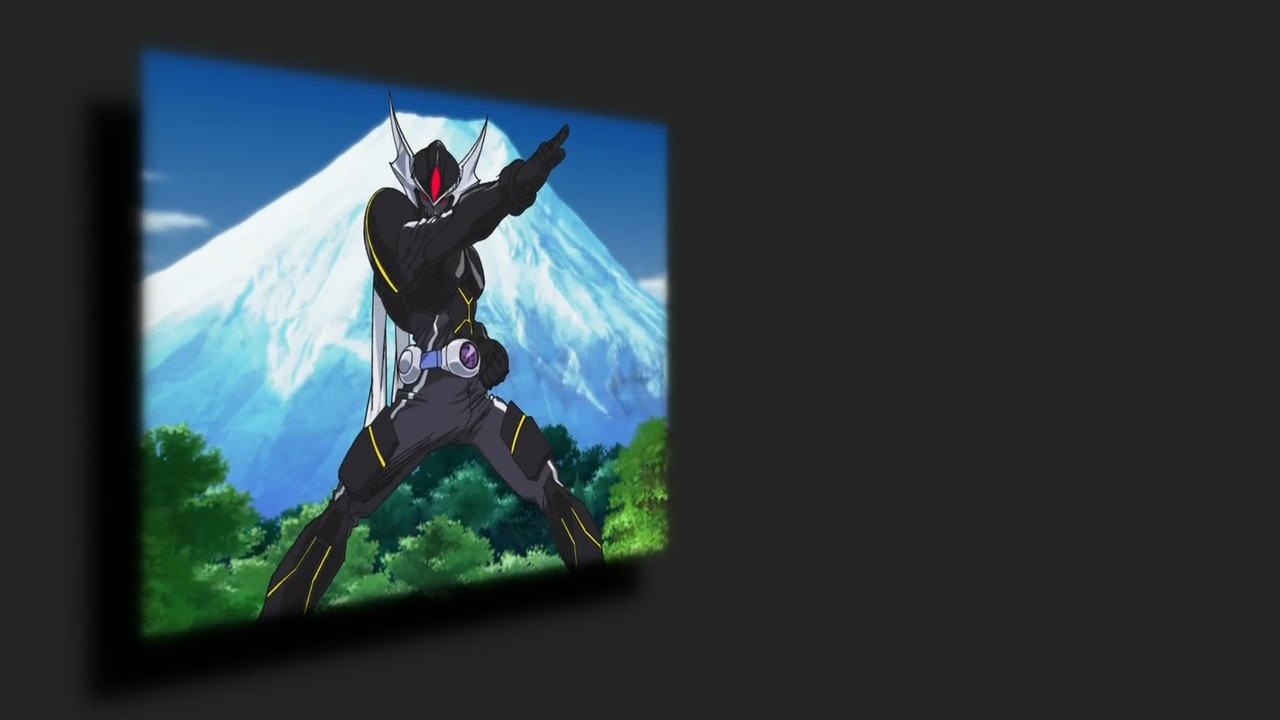
(24:03)
Iron Striver's pose is mimicking that of Kamen Rider 1 from "Kamen Rider" (仮面ライダー), a Japanese TV show about a masked super hero that aired from 1971 to 1973. Image for reference:
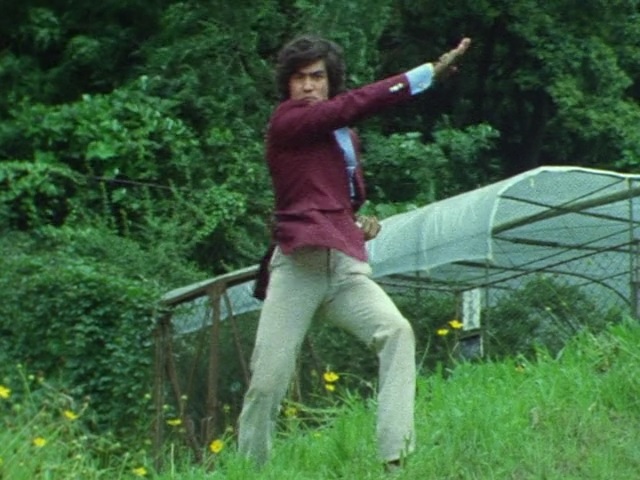
"My Mahiro and the Evil Gods fight too much!" (24:14)
The Japanese line is "Watashi no Mahiro-san to Jashin tachi ga shuraba sugiru!" (私の真尋さんと邪神たちが修羅場すぎる!). This is referencing "Ore no Kanojo to Osananajimi ga Shuraba Sugiru" (俺の彼女と幼なじみが修羅場すぎる), "My Girlfriend and My Childhood Friend Fight Too Much", a light novel series written by Yuuji Yuuji (裕時悠示) and published from 2011 and is currently ongoing.S1
"Real" (24:20)
"Bout High School!" (24:21)
Mahiro says, "Riaru" (リアル), and Nyaruko says, "Bauto Hai Sukuuru!" (バウトハイスクール!). This is referencing "Shoukan Kyoushi Riaru Bauto Hai Sukuuru" (召喚教師リアルバウトハイスクール), "Summoned Teacher Real Bout High School", a light novel series written by Saiga Reiji (雑賀礼史) and published from 1997 to 2010.S2
"Good self-performance!" (24:22)
The Japanese line is "Jienotsu!" (自演乙!). This is the name of a club which the main characters are a part of in "Ore no Kanojo to Osananajimi ga Shuraba Sugiru" (俺の彼女と幼なじみが修羅場すぎる), "My Girlfriend and My Childhood Friend Fight Too Much".S2 The name "Jienotsu" (自演乙) is actually a shortening for "Mizukara wo Enshutsu Suru Otome no Kai" (自らを演出する乙女の会), which translates to "Club for Maidens to Produce Themselves".
On June 16, 2013, the official anime website for "Haiyore! Nyaruko-san", http://nyaruko.com/, appears as follows:
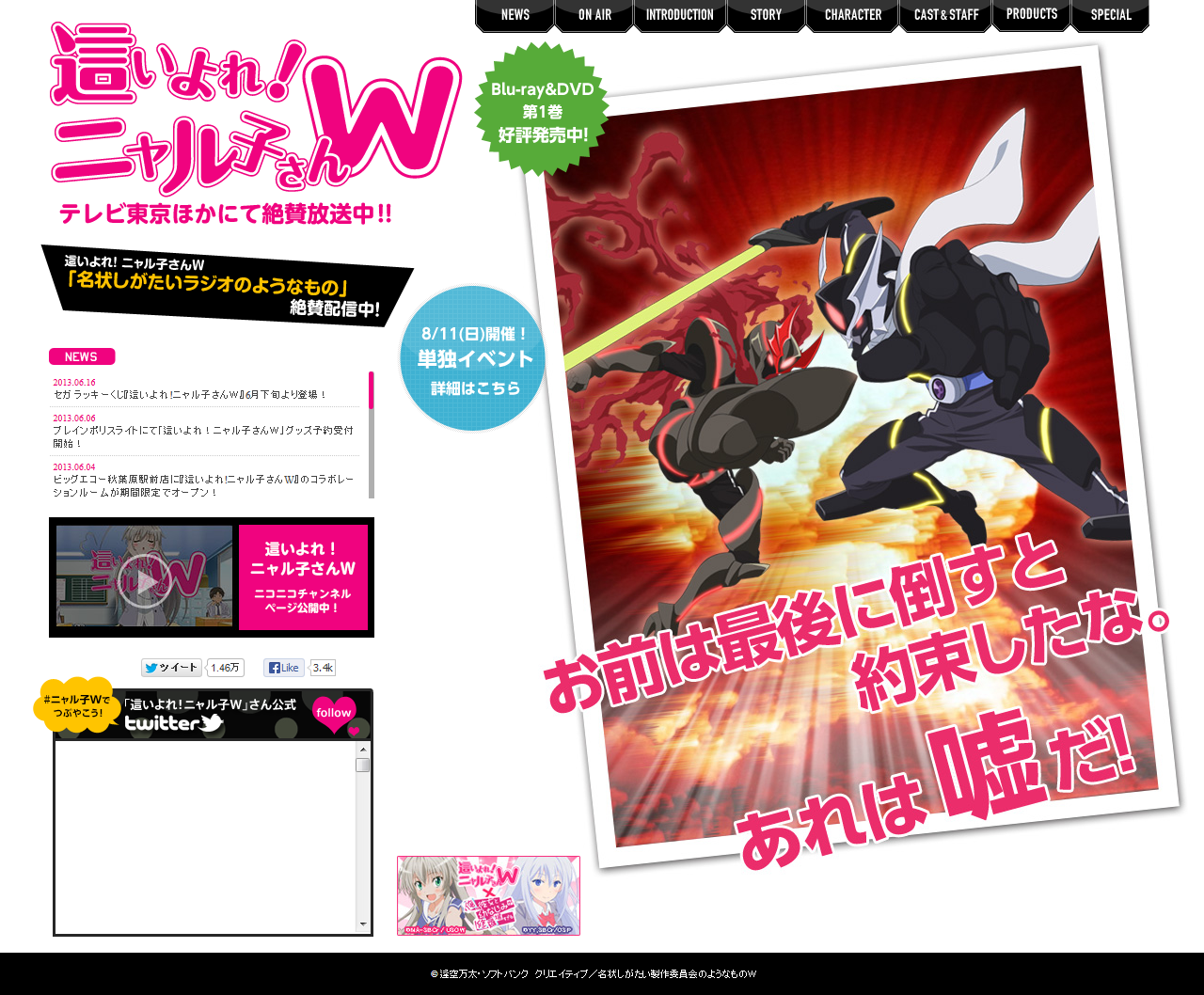
The text reads, "Omae ha saigo ni taosu to yakusoku shita na. Are ha uso da!" (お前は最後に倒すと約束したな。あれは嘘だ!), which translates to "I promised to defeat you last. That was a lie!". This is referencing a line said by John Matrix in Commando (コマンドー), an American movie released in 1985. The original line is "Remember, Sully, when I promised to kill you last? I lied." The Japanese dub of the movie translates this line as "Omae ha saigo ni korosu to yakusoku shita na. Are ha uso da." (お前は最後に殺すと約束したな。あれは嘘だ。), which translates to "I promised to kill you last. That was a lie."
List of Sources:
S1. Comments on this post
S2. A post at Steman Blog (ステマブログ)
S3. A blog by servitors about Cthulhu Mythos inspired works (クトゥルー/クトゥルフ神話作品発掘記)
S4. Japanese Nyaruko References Wiki (這いよれ! ニャル子さん 元ネタwiki) - Nyaruko W Episode 10
S5. Japanese Nyaruko References Wiki (這いよれ! ニャル子さん 元ネタwiki) - Nyaruko Light Novel Series Volume 7, Chapter 5
Thanks to everyone who contributed! This list wouldn't be nearly as long without you all. See you next episode!
情報を教えてくださって本当にありがとうございました!皆さんがいなかったら、このリストはぜんぜん長くありません。またこの次までね!
Last updated January 3, 2022
Sitemap
Home
